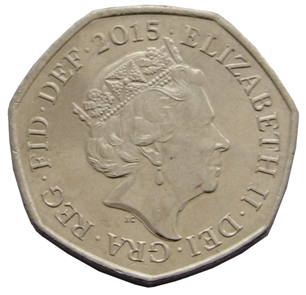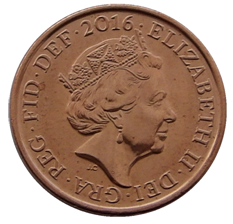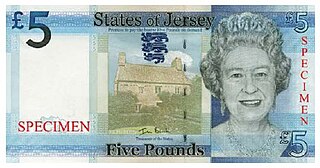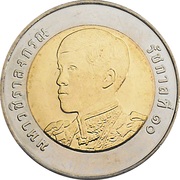Related Research Articles

The standard circulating coinage of the United Kingdom, British Crown Dependencies and British Overseas Territories is denominated in pounds sterling, and ranges in value from one penny to two pounds. Since decimalisation, on 15 February 1971, the pound has been divided into 100 (new) pence. Before decimalisation, twelve pence made a shilling, and twenty shillings made a pound. British coins are minted by the Royal Mint in Llantrisant, Wales. The Royal Mint also commissions the coins' designs.

Elizabeth Angela Marguerite Bowes-Lyon was Queen of the United Kingdom and the Dominions of the British Commonwealth from 11 December 1936 to 6 February 1952 as the wife of King George VI. She was the last Empress of India from her husband's accession as King-Emperor in 1936 until the British Raj was dissolved in August 1947. After her husband died, she was known as Queen Elizabeth The Queen Mother, to avoid confusion with her daughter, Queen Elizabeth II.

The British decimal fifty pence coin is a unit of currency equalling one half of a pound sterling. It is a seven-sided coin formed as an equilateral-curve heptagon, or Reuleaux polygon, a curve of constant width, meaning that the diameter is constant across any bisection. Its obverse has featured the profile of Queen Elizabeth II since the coin's introduction in 1969. Four different portraits of the Queen have been used, with the latest design by Jody Clark being introduced in 2015. The second and current reverse, featuring a segment of the Royal Shield, was introduced in 2008.

The British decimal one penny (1p) coin is a unit of currency equalling one-hundredth of a pound sterling. Its obverse has featured the profile of Queen Elizabeth II since the coin's introduction on 15 February 1971, the day British currency was decimalised. Four different portraits of the Queen have been used on the obverse; the latest design by Jody Clark was introduced in 2015. The second and current reverse, designed by Matthew Dent, features a segment of the Royal Shield and was introduced in 2008. The penny is the lowest value coin ever to circulate in the United Kingdom.

The British decimal halfpenny coin was introduced in February 1971, at the time of decimalisation, and was worth one two-hundredth of a pound sterling. It was ignored in banking transactions, which were carried out in units of 1p.

The British crown, the successor to the English crown and the Scottish dollar, came into being with the union of the kingdoms of England and Scotland in 1707. As with the English coin, its value was five shillings.

Mary, Crown Princess of Denmark, Countess of Monpezat, is the wife of Frederik, Crown Prince of Denmark. Frederik is the heir apparent to the throne, which means that should he succeed, Mary will automatically become queen consort of Denmark.

The pound is the currency of Jersey. Jersey is in currency union with the United Kingdom, and the Jersey pound is not a separate currency but is an issue of banknotes and coins by the States of Jersey denominated in pound sterling, in a similar way to the banknotes issued in Scotland and Northern Ireland. It can be exchanged at par with other sterling coinage and notes.
Canadian royal symbols are the visual and auditory identifiers of the Canadian monarchy, including the viceroys, in the country's federal and provincial jurisdictions. These may specifically distinguish organizations that derive their authority from the Crown, establishments with royal associations, or merely be ways of expressing loyal or patriotic sentiment.

The bi-metallic Thailand ten-baht coin is a denomination coin of the Thai baht, the currency unit of Thailand.
The cent, formally the one-cent coin, was the lowest-denomination coin of the Australian dollar. It was introduced on 14 February 1966 in the decimalisation of Australian currency and was withdrawn from circulation in 1992. It is still minted as a non-circulating coin.
Commemorative coins have been issued by the Royal Mint in the United Kingdom since 1935. Initially they only came out to mark events of great interest, but since the turn of the millennium have been minted yearly.
This article concerns the coins of the New Zealand dollar.

Elizabeth II is Queen of the United Kingdom and 14 other Commonwealth realms.
The ten-cent coin is the lowest-denomination circulating coin of the Hong Kong dollar. With a diameter of 17.5 mm and a mass of 1.85 g it is also the smallest in size and weight. It is the oldest coin denomination to still be in circulation in Hong Kong. Since its first issue in 1863, there has only been one period (1942–1947) where the coin was not in use.
The five dollar coin is the second-highest denomination coin of the Hong Kong dollar. It replaced the five dollar banknotes in 1976.

Halaevalu Mata'aho ʻAhomeʻe was the Queen Consort of Tonga from 1965 to 2006, and the widow of the late King Tāufaʻāhau Tupou IV of Tonga. She was the mother of King George Tupou V and the current King of Tonga, Tupou VI.
The New Zealand fifty-cent coin is a coin of the New Zealand dollar. It was the largest by denomination, diameter and mass to have been introduced on the decimalisation of the currency on 10 July 1967, replacing the pre-decimal crown coin. A total of 81,585,200 pre-2006 50 cent coins were issued, with a total value of $40,792,600.00

The Ruby Jubilee of Elizabeth II in 1992 marked the 40th anniversary of the accession of Queen Elizabeth II to the thrones of the United Kingdom and other Commonwealth realms. Contrary to her Silver Jubilee in 1977, there were no widespread public celebrations of the Ruby Jubilee; it was a low-profile event. However, there were some observances to mark the milestone.
References
- ↑ "Worldcoingallery.com". Worldcoingallery.com. 2006-11-29. Retrieved 2017-02-24.
- ↑ "Worldcoingallery.com". Worldcoingallery.com. 2006-11-29. Retrieved 2017-02-24.
- 1 2 "Worldcoingallery.com". Worldcoingallery.com. 2006-11-29. Retrieved 2017-02-24.
- ↑ "Worldcoingallery.com". Worldcoingallery.com. 2006-11-29. Retrieved 2017-02-24.
- ↑ "Worldcoingallery.com". Worldcoingallery.com. 2006-11-29. Retrieved 2017-02-24.
- ↑ "Worldcoingallery.com". Worldcoingallery.com. 2006-11-29. Retrieved 2017-02-24.
- ↑ "Worldcoingallery.com". Worldcoingallery.com. 2006-11-29. Retrieved 2017-02-24.
- ↑ "Worldcoingallery.com". Worldcoingallery.com. 2006-11-29. Retrieved 2017-02-24.
- ↑ "Worldcoingallery.com". Worldcoingallery.com. 2006-11-29. Retrieved 2017-02-24.